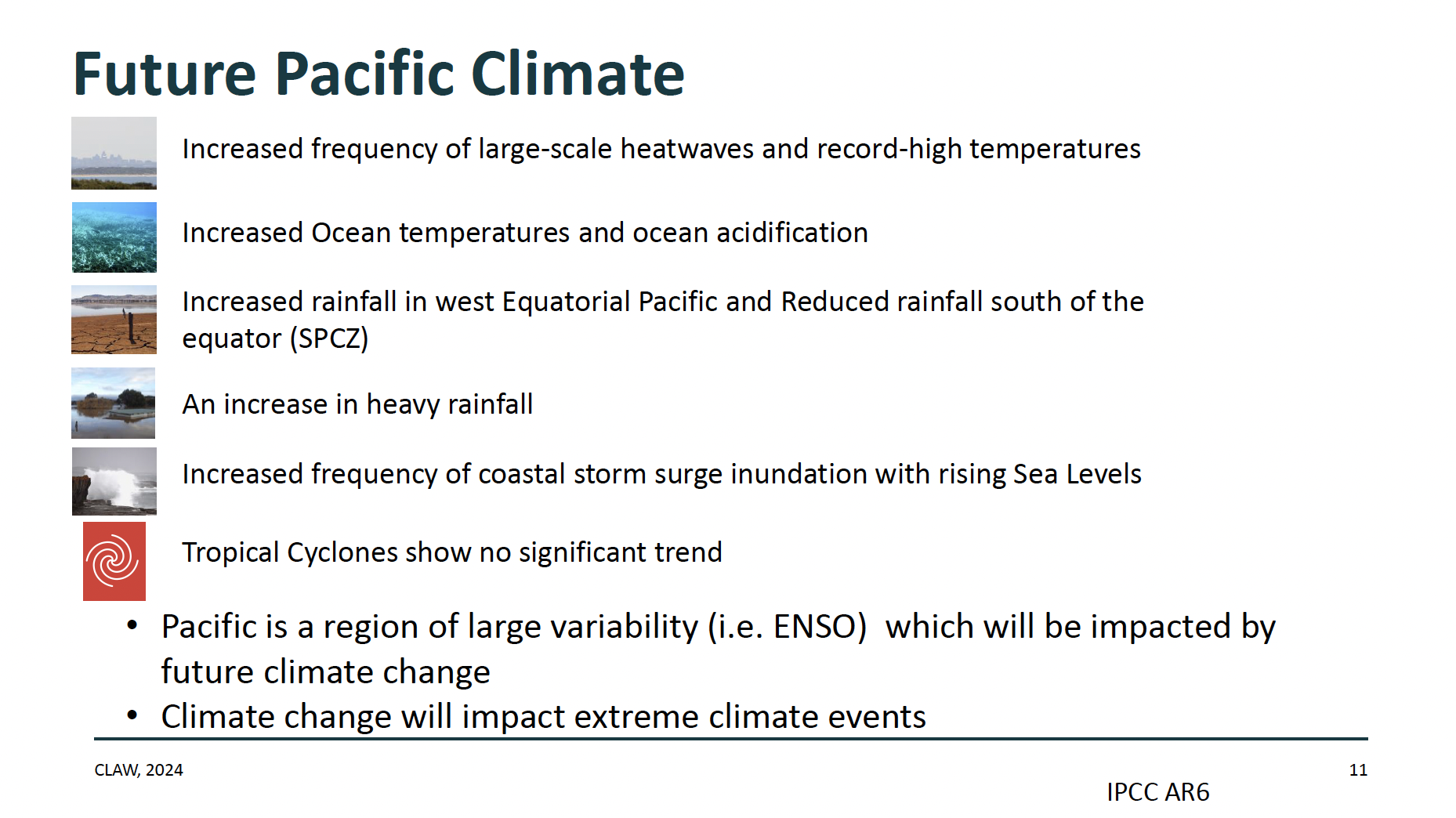Continuing with my Climate Change in Fisheries Series (CCFS), here is my 4th on the Basics of climate change in the WCPO .
Richard Matear from CSIRO presented the basics of climate change. He is the Climate Intelligence Portfolio Leader at CSIRO’s Decadal Climate Forecasting Project in Australia. His presentation focused on differentiating between climate variability and climate change and introduced anthropogenic factors causing environmental changes associated with climate change.
The presentation emphasised the role of oceans in the climate system. The oceans absorb most (90%) of the anthropogenic heating and will be the ultimate repository for about 80% of our anthropogenic carbon dioxide emissions. Unfortunately, the ocean uptake of carbon dioxide is slow (1,000s of years) in preventing climate change. Thus, it is important to manage greenhouse gases actively to achieve global climate change goals. The world is making positive steps to reduce emissions, but these need to be accelerated.
The climate has changed in the Pacific over the last 70 years (e.g., the surface has warmed), but separating anthropogenic climate change from natural variability is challenging because the region has large interannual (e.g. ENSO) and decadal variability that have large impacts on the climate and the weather.
The future climate will continue to change as the earth warms. Climate change occurs at the global, regional and local scale, and there is a need to understand the local impacts. The impacts of climate change, such as on fisheries, are also both chronic and acute.
Climate change may alter the climate, amplify the ENSO cycle and alter the frequency and magnitude of extreme climate events. For example, as the region warms, one expects increased frequency and severity of heat waves (land and marine); coral bleaching, which will damage plants and other organisms which will have cascading impacts on ecosystems (e.g. loss of seagrass due to warmer water reducing key habitat for the juvenile fish altering the fish biomass and diversity of a region). Corals are starting to inhabit areas that were previously not suitable habitat due to high temperatures shifting poleward, suggesting a grim future for coral reefs in the tropics if global warming continues. The compound risks, such as stressing organisms and removing important species, could lead to the prevalence of invasive species.
The consequences of climate change may have unforeseen consequences. For example, there was a massive mortality event of snow crabs in the North Pacific because the warming water increased their metabolism faster than their ability to eat enough food and they died of starvation.
The importance of considering complex risks and how they can amplify the consequences of climate change was noted. The impacts of climate change are not confined to local areas, as events such as sea level rise can lead to global migration. Local information is important in understanding the impacts of climate change, and developing a project on ocean certification would be useful.
Increasing the number of monitoring stations in a region could provide valuable insights, improve the accuracy of models and reduce uncertainty. The complexity of climate and weather systems and the need for quantitative measures to understand and predict changes was stressed.
The relationship between climate change and tropical cyclones is difficult to predict due to their infrequent occurrence. There may be a decrease in the frequency of tropical cyclones, but an increase in intensity due to the higher heat in the atmosphere.
Discussion
The risks of how things compound as the climate changes was discussed. It is relatively common to oscillate between rain, drought and fires. As an example, climate change can cause droughts resulting in the die off of vegetation, which can result in increased fires, this can be followed by heavy rain, which then causes flooding and washes the soil away as there were no plants to hold it in place.
These extreme impacts can result in compounded effects in sequential seasons or years. In addition, when you push a system and damage it, other organisms will take over so impacts like coral bleaching can cause a proliferation of unwanted species that can cause additional damage to the system.
Ocean acidification information is generated from a limited network, but these data are important. Big CO2 oscillations can occur in a short period of time and vary locally, so local data collection is critical, and data from many local areas around the Pacific is required.
Climate scientists use an ensemble of models, and both the observation of the event and the observations of the parameters are required to improve the models. Both are equally important to evaluating the impact of climate change and its consequences. Cyclones, for example, are difficult to predict. There seems to be a link between ENSO and cyclones.
However, the numbers are small, and developing models based on a few observations is challenging to resolve and more observations are needed. There may be fewer but larger cyclones as the atmosphere warms.
El Niño impacted the 2023 record temperatures and sea surface temperature trends at the equator. Analysis of the event showed that the heat gradient from east to west was steeper than expected, which is inconsistent with the model predictions. It is important to understand these physical changes and how they may alter future current flows and other physical ocean characteristics.


